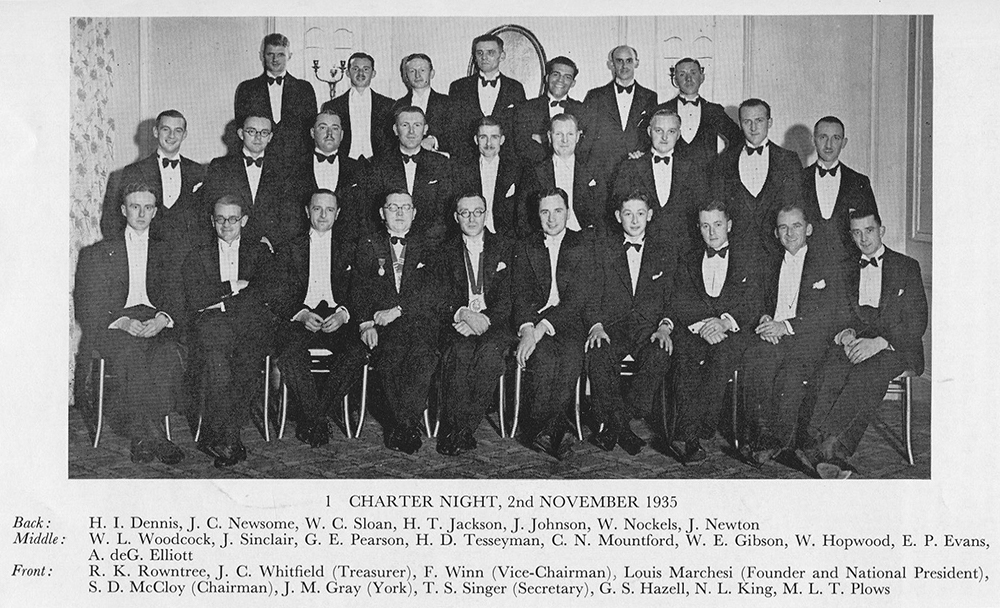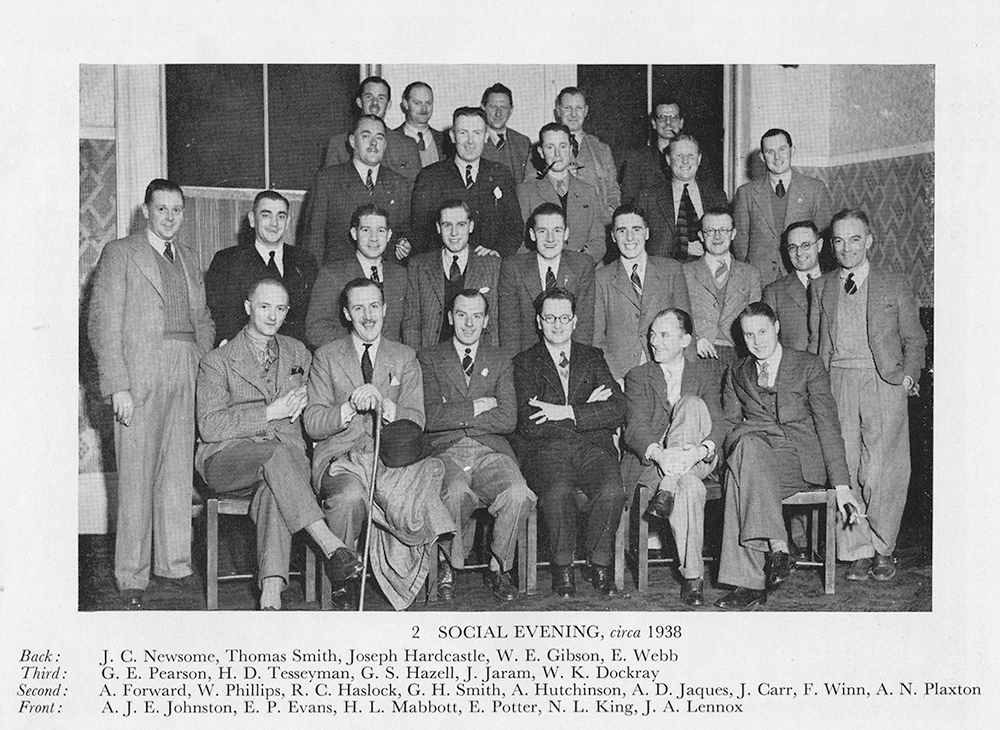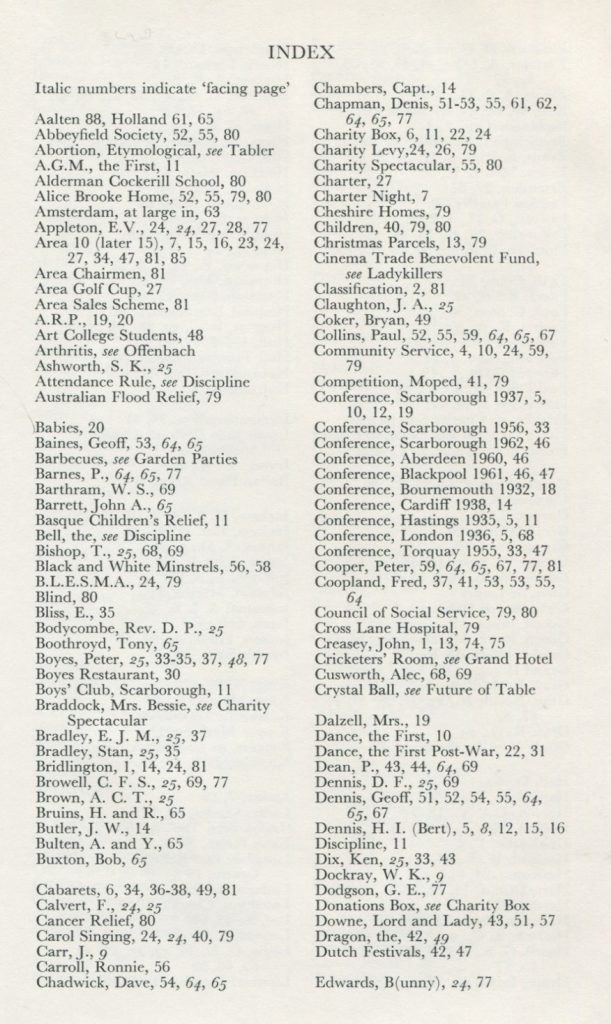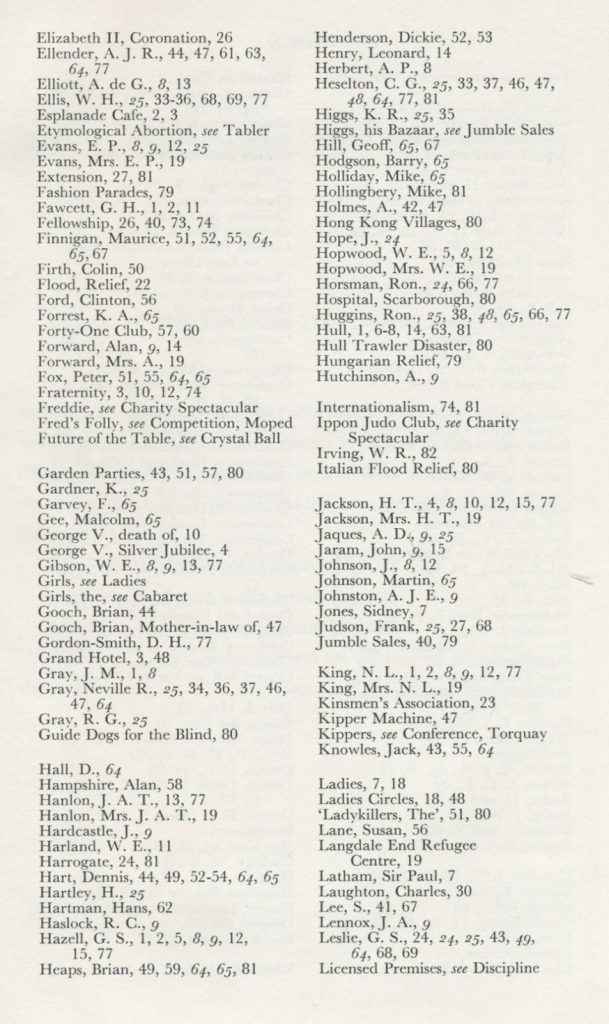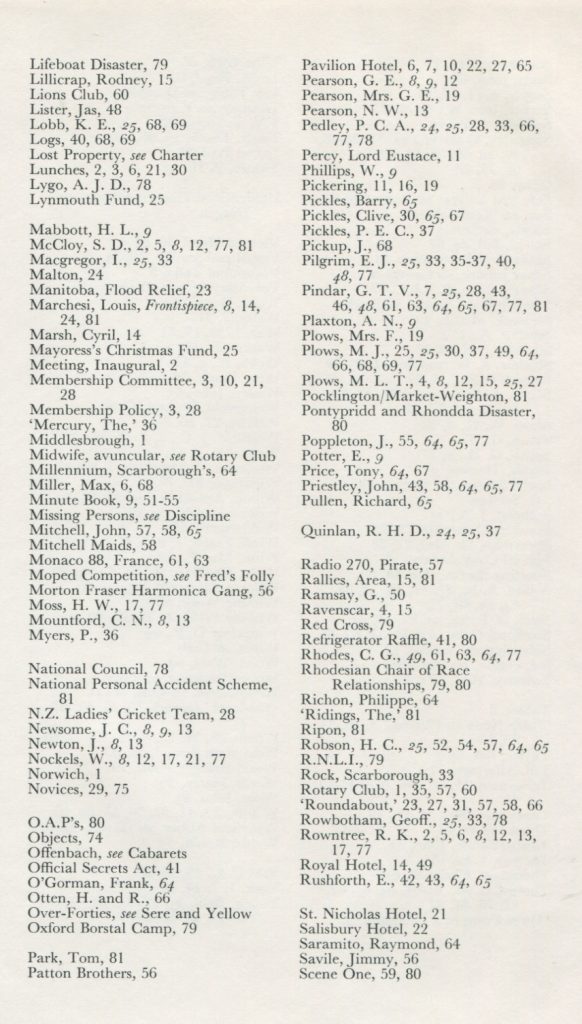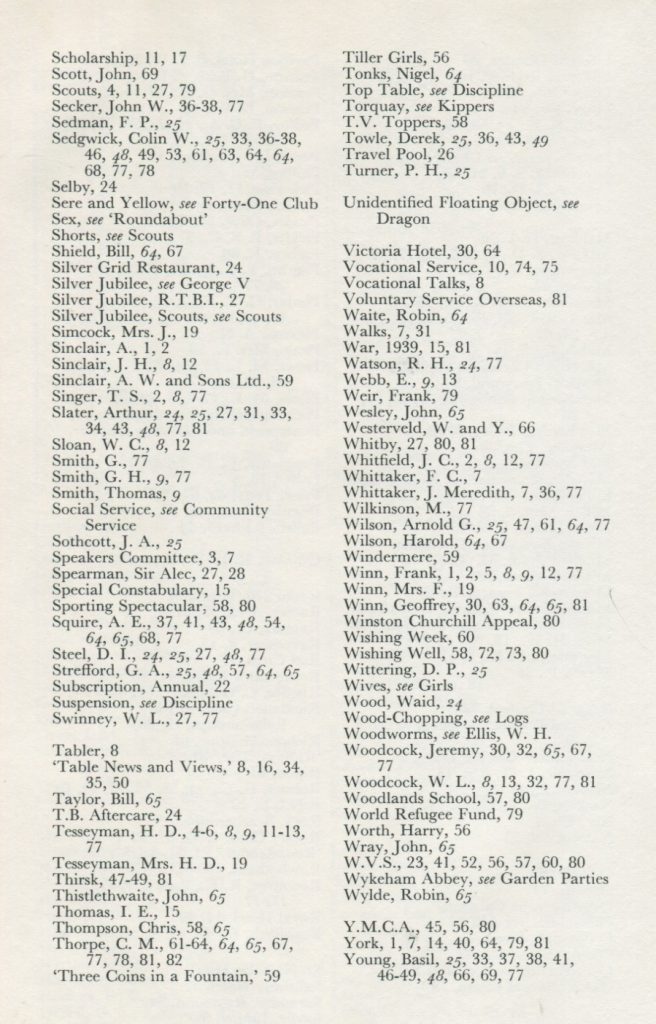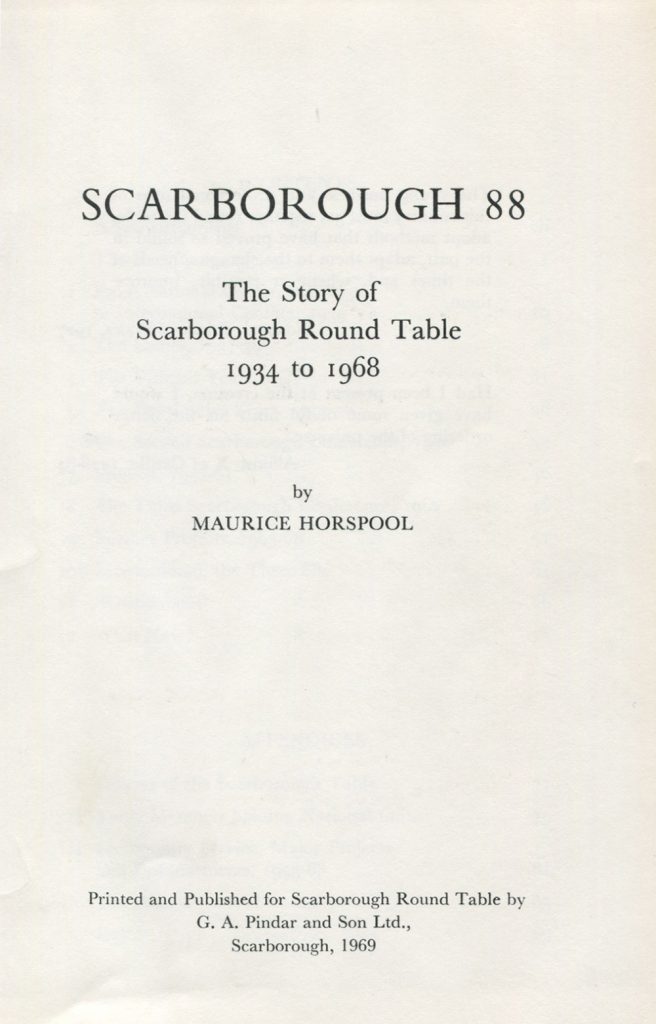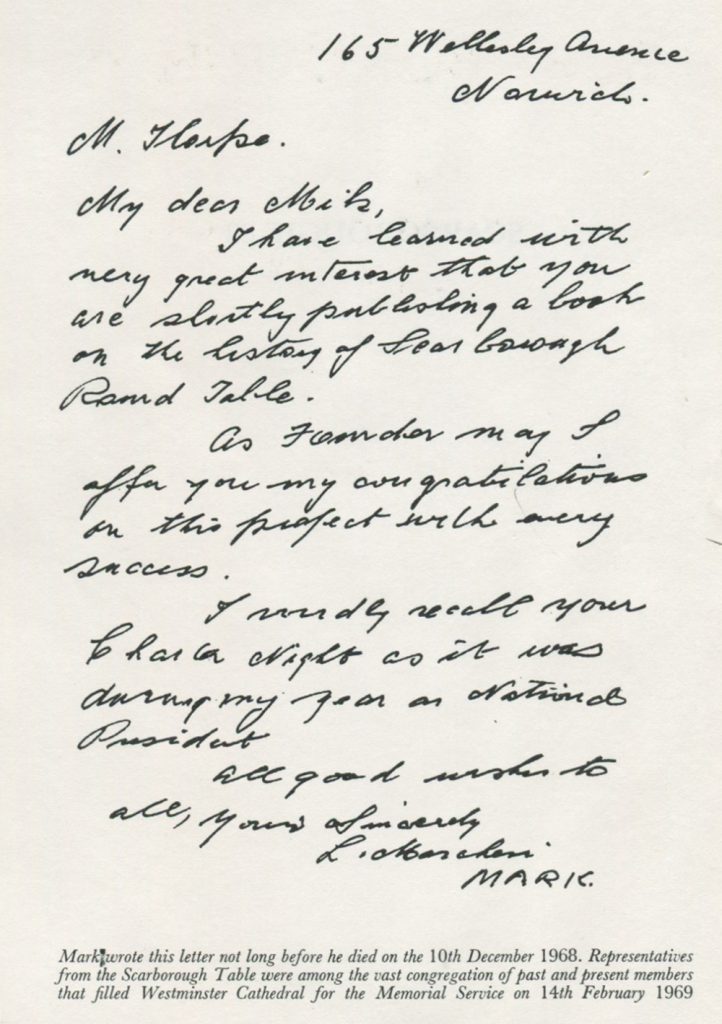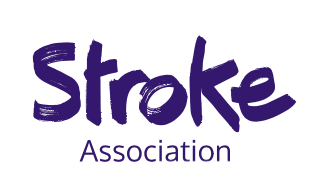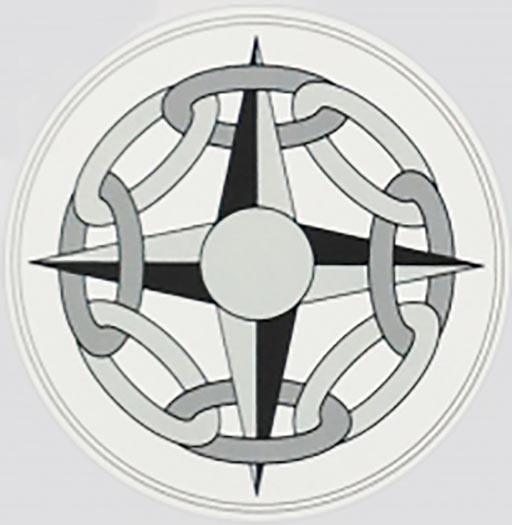The Second Scarborough Conference, 1956
IT IS A GENERALLY ACCEPTED fact that the 1956 Scarborough Conference started the previous year in Torquay. In the sedate days of the first Scarborough Conference, the invitation had been given with becoming decorum by Frank Winn, who merely stood up at the London Conference and invited everybody to come to Scarborough the following year. And without any more ado they did.
Tempora mutantur, nos et mutamur in illis (our dads were not the men we are). Things were different at Torquay, twenty years later, but the proceedings started decorously enough. Eleven pillars of the Scarborough Conference and ten of their wives went to Torquay, ostensibly for guidance and information on the problems of conference organisation, actually to persuade as many as possible to come north in 1956.
They took with them some thousands of sticks of Scar borough rock, in Table colours, looking not unlike charges of hygienic gelignite, which they distributed with a prodigality that in London a generation earlier would have amounted to electoral bribery. It was, however, merely a foretaste of better things to come. Less popular were the reams of stickers stuck by the Scarborough contingent on all cars in sight.
The theme of Scarborough’s Conference publicity was to be ‘The Frozen North’. This was a sufficient reason for Peter Boyes, Basil Young, Ian MacGregor, Geoff Heselton, Arthur Slater, Philip Pedley, Geoff Rowbotham, Ken Dix, Ernie Pilgrim and Bill Ellis to turn themselves into cavemen, with Colin Sedgwick as a penguin dragging a large sledge.
In the closing stages of the final night’s Fancy Dress Ball the northern troglodytes made a dramatic appearance on [33] the floor of Torquay’s immaculate Town Hall, with intention of capturing the newly elected National President and putting him on ice for 1956. If they had stuck to of rock, all would yet have been well, but on the sledge were five boxes of Scarborough kippers.
‘These’, writes Colin Penguin, whose experiences of their culinary properties was greater than his appreciation of their ballistic potentialities, ‘were thrown to the waiting hundreds, who in true R.T. tradition, threw them back. In less than a minute coveys of kippers were flying to and fro.
slapping against flesh, slipping behind radiators, staining costumes and smearing the windows and walls of the pride of Torquay. When order was restored their aromatic juices were still being trodden into the boards. They lingered there for many weeks, and when the central heating was started up the following winter Scarborough’s fragrance was renewed from hidden sources.’
The R.T. National Conference has not been back to Torquay since. The politely accepted reason is that the town is no longer large enough to accommodate it.
The Frozen North, and to 5th May 1956
After the preview at Torquay, Scarborough had to justify the promise it had held out. Peter Boyes, then Chairman, considered that, as usual, a professional cabaret should be staged. In this he ran into opposition from Bill Ellis and others of like ilk, who saw no reason why the Table should not stage its own cabaret. To prove it they mounted a show at the Chairman’s Ladies’ Night which was so successful that nothing more was heard about professionalism.
Arthur Slater was Area Chairman, and at his Conference Reception at the Royal on the Wednesday, the cabaret got off to a good start. ‘The cabaret spot provided by Scar borough Table’, reported News and Views, ‘bettered the London professional chorus line … These boys were coached by Tabler Neville Gray, who was also responsible for the expert sound engineering needed for the miming act and who, incidentally, as Councillor Gray, Chairman of the Borough Entertainments Committee, contributed to the success of the Conference in other respects. Even the Conference Committee, when introduced, looked as if they had [34] just been through an air raid, for the Scarborough Table just refuses to take itself too seriously about anything’. The Committee’s battered, bloodstained, bandaged and be-splinted bodies may have hampered movement, but they got the Conference off at a cracking pace. It was described by the National President, Eric Bliss, as ‘fabulous’, a word he was to use again on the Friday. By Saturday night (vide News and Views) he was speechless.
It was at the Civic Reception the following evening, Thursday, that Bill Ellis and Ernie (‘Don’t ‘ee worry’) Pilgrim (‘who also found time to be Chief Steward without exceeding a steady walking pace’) burst upon the National scene with ‘Water can’t quench the fire of love’. Thus they ensured for themselves a reputation that, as they have, has gone beyond the confines of the Table, the former for his inexhaustible rhymes of the thymes, the latter for his pawky* impromptus.
*This word has no vocational significance.
The Rotary Club’s obstetric functions have already been mentioned in these pages. On the Friday, at the National President’s Ball at the Olympia, the Club displayed other aptitudes by presenting a dead-pan excerpt from ‘Swan Lake’, the third cygnet from the left being Peter Boyes.
The President’s Ball went on until 1 a.m. By 7.45 p.m. the following evening the hall had to be ready for the farewell fancy dress party, naively named ‘Native Nite’. The preparations for this party had been going on for months, and many hundreds of Table-man-hours had been expended, under the direction of Stan Bradley, whose premises had been constantly in use as workshop and store. The quantity of scenic decoration that had been made and painted was enormous. All through the Friday night the Table worked, and gradually what had been an idea at last became reality.
Ken Higgs had designed and made four mammoth ‘mobiles’ to hang from the ceiling, representing the four quarters of the globe. Murals on stretched hessian covered the walls. The pillars were transformed into totem poles.
The entrance to the Polar Bar on the balcony was an igloo with its curtain of icicles, and the Jungle Juice Bar was appropriately decorated. [35]
‘The impact on the Tablers as they entered the hall,’ writes Colin Sedgwick, ‘was electrifying, and the scene was set for a magnificent event. Spirits ran high* and high jinks were the order of the day.
*There were four bars.
‘Towards the end of the evening, over-enthusiastic Tablers began to take down varying items of décor as souvenirs, not as carefully as they might have done, and the recently-decorated hall suffered a little. Many of the items were seen leaving Scarborough on the tops of cars the following day.
‘Finally, at midnight, one party tried to launch a totem pole as a canoe, and got the inevitable ducking, which didn’t dampen their spirits at all and delighted the onlookers.’
As guests left for their hotels, 90% of them in the St. Nicholas Cliff area, there to whoop it up until dawn, they were each, through the careful organisation of Meredith Whittaker and his staff, presented with a special Conference Edition of the Mercury. This included three full pages of Conference photographs together with a picture of the President of Round Table International, Peter Myers, being sacrificed by druids at Stonehenge a matter of minutes earlier.
As was usual, a certain amount of business was done at the Conference, but nobody seems to remember much about it. In any case, it is all (one hopes) in the national archives.
The Cabaret
This was the beginning of the golden age of the Table Cabaret, for what it had done at the 1956 Conference established it as an important ingredient of the Table’s future social activities. In Bill Ellis the Table had a script writer who, after months of mental anguish, would come up with lyrics fresh with the dew of inspiration, not infrequently with a little earth still clinging to their roots. In Ernie Pilgrim the Table had an urbane compère and raconteur whose polished impromptus have already been mentioned, and in Neville Gray, an electronic perfectionist. On this trio the brunt of all cabarets fell, except in the year when Bill Ellis was Chairman, when Derek Towle deputised for him.
John Secker recalls the time after the purchase of the Spa by the Corporation in the late 50’s, when four members [36] of the Table – Ernie Pilgrim, Peter Boyes, Bob Quinlan and Neville Gray – were also members of the Borough Council. The following quatrain from The Councillors’ Song was inevitable:
I’m Quinlan, I’m Pilgrim, I’m Boyes and I’m Gray.
We’re stuck with the Spa and we can’t make it pay.
The Council decided the men for the job
Were Peter and Ernie and Neville and Bob.
The basis of the Ellis-Pilgrim partnership rested on:
1 A topical song relating to members of the Table, their various activities in and out of the Table – e.g. “The Councillors’ Song.
2 A mime of some popular song pre-recorded by Neville Gray – e.g. ‘Whispering Sands’ with Bill as a dying prospector and Ernie as a highly successful angel. The partnership became a trio occasionally, as with Fred Coopland in the Ying Tong Song.
No member of the Table was safe from Bill Ellis’s lilting pen. It is, however, not the aim of this history to publish libels, however long ago they were perpetrated, or however great the temptation. Nevertheless one classic stanza has remained with varying degrees of accuracy in the minds of many members of the Table, and in the interests of scholarship the definitive version is here given. Its subject combined a directorship of a large department store with rural, agricultural and equestrian pursuits.
Percy Pickles, they say,
Is a horseman at heart.
He goes riding, jolly well riding.
The horse would be better
Off pulling a cart,
When he’s riding, jolly well riding.
In his new riding jacket,
His new riding cap,
He really looks handsome,
A most dashing chap.
In the fields as he passes
The cows stand and clap.
When he’s riding, jolly well riding.
The Dancing Girls
The more physically energetic section of the Cabaret was the sextet of dancing girls in the later 1950’s. Ex- or old-girls of the troupe are Colin Sedgwick, Basil Young, Geoffrey Heselton, John Bradley, John Secker, Tony Squire, Michael [37] Plows and Derek Towle. The costumes were made by long-suffering if not altogether approving wives.
These girls performed (in spite of a Council resolution that they shouldn’t) at the 41-Club Conference in 1960. At this performance it was decided that the turn should be delicately guyed. Colin Sedgwick suggested that it should be built round John Secker, as he was always half a beat behind everybody else. John’s comment is that by the time the performance took place he had arthritis. How far that was attributable to Offenbach is not clear.
The Great Storm of 1958
Here, perhaps is the place for a brief word on the most important of the Table’s occasional periods of self-examination mentioned on page 68. Council and membership had fallen a little out of step, and Tom Pindar has had the task of putting his recollections on paper:
When a storm breaks, one often wonders why the signs of its approach had gone unheeded, but is then comforted to remember that once events are moving its arrival is as inevitable as the delightful freshness that succeeds it.
Thus it was with Table year 1958-9. Events flowed along pleasantly, but there was an ill-defined feeling that some thing was due to happen. There was talk of another Conference, and Council met to discuss the formation of a Shadow Conference Committee.
Peter Boyes, Chairman of the 1956 Conference, attended the meeting and after discussion it was agreed to invite Basil Young to be Conference Chairman, John Secker to be Secretary. Further appointments would follow later. This was on the 24th November,
By 22nd December the storm was rumbling loudly and a letter reached Ron Huggins, Table Chairman, offering criticisms of and suggestions for the running of the Table. Covering three sides of foolscap and signed by 10 Table members, it could be taken as indicative of serious discontent.
A special general meeting was called to discuss the letter and the 2 1/2-page Council point-by-point reply bore the signatures of all its 9 members. One Council member had [38] the distinction of signing both letters. A blood-bath was expected, and there was a good turnout to see the sport. The meeting was remarkable for the skilful chairmanship of Ron Huggins and the readiness for sense and reason shown both sides as well as by the non-combatants.
So, the storm was over. It was a milestone (if not a landmark – Ed.) in Table history, for after it there was a greater sense of unity and of respect for Chairman and Council. Some reforms began to emerge, but the Conference Officers appointments, which had caused much of the storm, came to nothing, because Scarborough was not selected until 1962, by which time a new method of appointment had been devised.
It is a curious coincidence that, as we go to press, Ron Huggins, now as President, should be writing in Roundabout from which, on page 70, we have filched an extract. [39]
